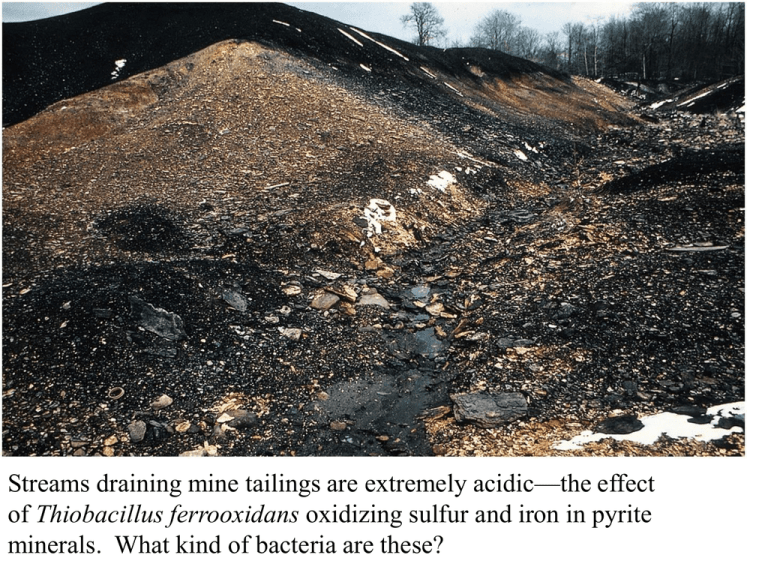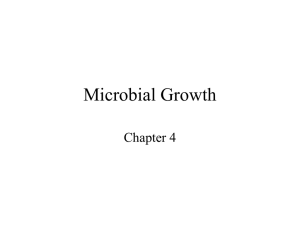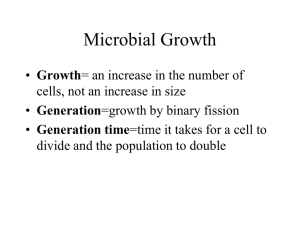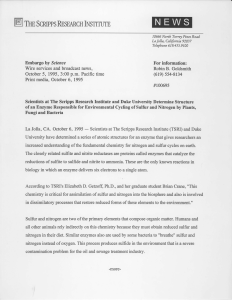Streams draining mine tailings are extremely acidic—the effect Thiobacillus ferrooxidans
advertisement

Streams draining mine tailings are extremely acidic—the effect of Thiobacillus ferrooxidans oxidizing sulfur and iron in pyrite minerals. What kind of bacteria are these? The Sulfur cycle has many important effects on Aquatic Ecosystems Chemoheterotrophs (CH) -2 -1 pyrites (PA) 0 +4 CH +6 PA Photoautotrophs (PA) Chemoautotrophs(CA) Thiobacillus ferrooxidans oxidizes both the iron, Fe(+2) to Fe(+3) and the sulphur in the pyrites, S(-1) to S(+6) using molecular oxygen. This reaction splits water to produce a great deal of acid. How do you suggest that mine tailings should be stored? 2FeS 2 7.5O2 4H 2O 4SO4 2 Fe2O3 8H Energy Hydrothermal vent fauna: a community founded on Thiobacillus a chemoautotrophic bacteria The pogonophoran tube worms harbour nodules of Thiobacillus inside their body cavities as mutualistic symbionts Desulfovibrio : Sulfate reducing bacteria commonly found in anaerobic aquatic environments with high levels of organic material, such as mud in lakes and ponds. •have metal reductases which can precipitate metal sulfides from the water— •bioremediation potentials for toxic radionuclides such as uranium by a reductive bioaccumulation process. Sulfate reduction can absorb H+ and counteract acid rain They also contribute to methylation of Mercury Chemical equation for the oxidation of acetate by sulfate CH 3COO SO 4 2 H S H 2O CO2 E 2 CH 3COO SO 4 H S 2 H 2O 2CO 2 ( 6) (0) (-2) ( 4) 8 e - are accepted per S - 4 e are donated per C Where do sulphate reducing bacteria fit in the functional classification? Purple Photosynthetic sulfur bacteria (eg Thiocapsa) http://www.esf.edu/efb/schulz/Limnology/Laboratory/PurpleBacteriafromGreenLake.JPG Thiocapsa are found most often in fresh water: lakes, sulfur springs, and waste water ponds. Requires anoxic conditions with light present. Under ideal conditions, Thiocapsa can form dense blooms. •use reduced sulfur as an electron donor during photosynthesis. They are capable of oxidizing both sulfide and other reduced sulfur compounds. gas vacuoles. Why? Chemical equation for anoxygenic photosynthesis in purple sulfur bacteria H 2 S CO2 light energy S CH 2O 12 H 2 S 6CO 2 12S C 6 H 12O 6 6 H 2O (-2) ( 4) (0) (0) - 2 e are donated per S - 4 e accepted per C In aerobic photosynthesis O2 is produced. Why is no O2 produced here? Redox profile at the earth’s surface The earth is a 0.5 V battery Photosynthesis --a strong photochemical redox reaction-has produced a strong redox gradient across the earth’s surface. Atmosphere, oxidizing environment This gradient helps maintain chemical diversity at the boundary Soil layer Earth’s crust, a reducing environment +0.25 0V -0.25 Consider the example of soil N



